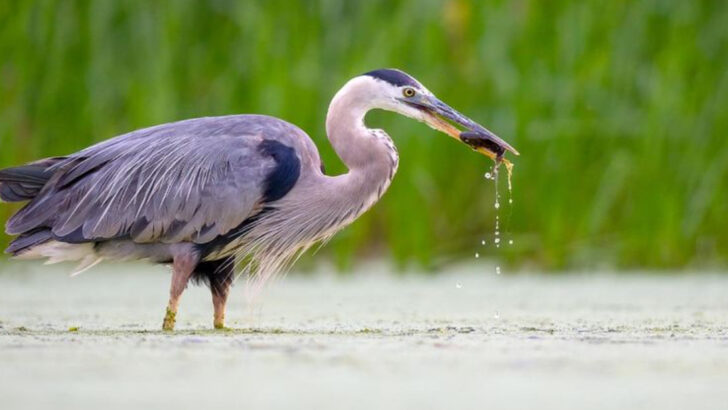Herons aren’t just birds — they’re drama on stilts. One moment they’re statues in the reeds, the next they’re airborne poetry with a six-foot wingspan and a fish flailing in their beak.
You’ll find them haunting lonely marshes, cruising mangrove forests, or perched like royalty by moonlit lakes. From backyard ponds to tropical coasts, these feathered hunters have claimed nearly every watery corner of the planet.
Ready to meet the stars of the heron world? These 12 striking species will take you on a globe-spanning tour — no binoculars required.
Great Blue Heron
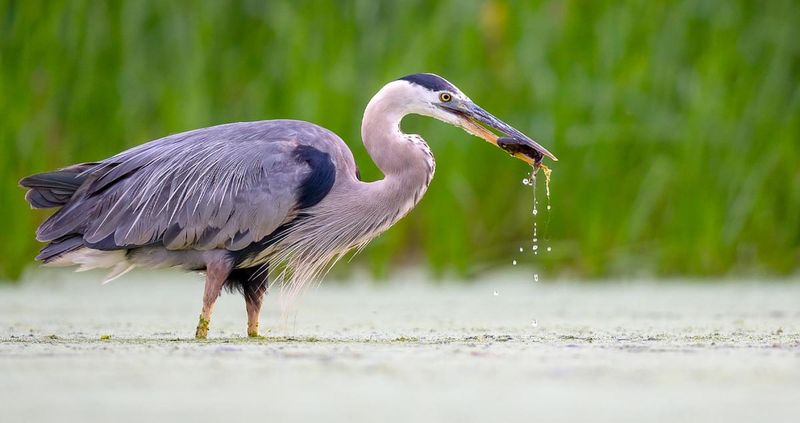
Elegance meets wilderness in the Great Blue Heron. Standing tall, this bird is often found in North American wetlands. Its striking blue-grey plumage and long legs make it an icon of beauty. If you wander through marshes or by the water’s edge, you might spot one fishing meticulously.
Known for their patience, Great Blue Herons stand motionless, waiting for the perfect catch. This characteristic hunting style distinguishes them from other birds.
During breeding season, they form colonies in trees near water, creating a bustling, lively environment.
Little Egret
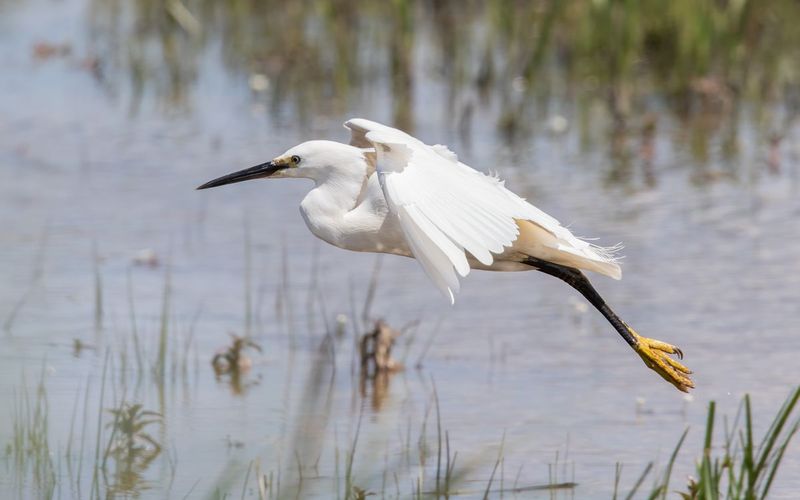
The Little Egret is a master of elegance. With pristine white feathers, it graces marshes across Europe, Asia, and Africa. This bird’s delicate appearance is matched by its agile hunting techniques.
Little Egrets use their feet to stir up aquatic prey, a behavior that intrigues observers. They are often seen alone, but during breeding season, they nest in colonies.
A favorite among birdwatchers, the Little Egret’s snowy plumage and slender black bill make it a standout in its wetland habitat, providing endless fascination for those lucky enough to observe it.
Green Heron
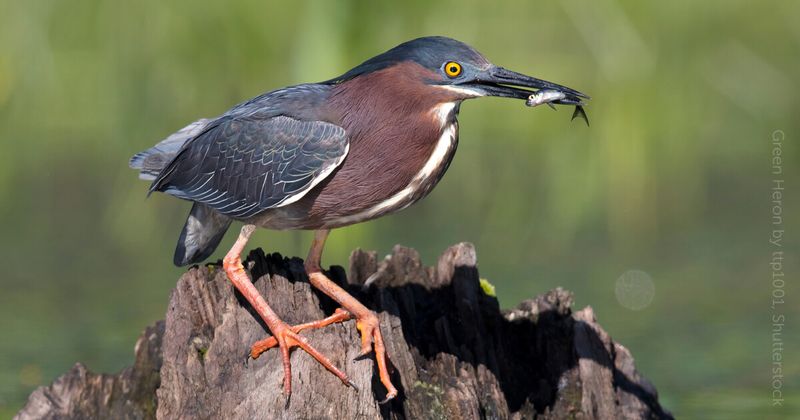
Quirky and colorful, the Green Heron is a small bird with a big personality. Found throughout North and Central America, it’s known for its striking green and chestnut plumage.
Unlike other herons, the Green Heron often uses tools, dropping bait into water to attract fish. This clever behavior showcases its intelligence.
Typically seen around wooded ponds and streams, they’re solitary and secretive. But if you catch sight of its bold colors against a lush green backdrop, it’s a moment to cherish, revealing nature’s vibrant palette.
Black-crowned Night Heron
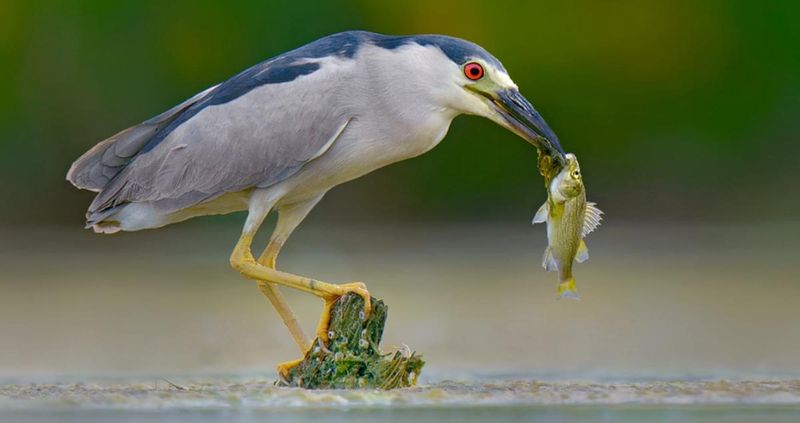
Mysterious and nocturnal, the Black-crowned Night Heron roams under the moonlit sky. Found worldwide, these herons are known for their striking black caps and robust bodies.
By day, they remain hidden, perched in trees or dense vegetation. Come night, they emerge to feed along water edges.
Their adaptability allows them to thrive in both urban and rural settings, making them a fascinating study for those interested in urban wildlife. Their role in the ecosystem as both predator and prey is vital, showcasing nature’s delicate balance.
Purple Heron
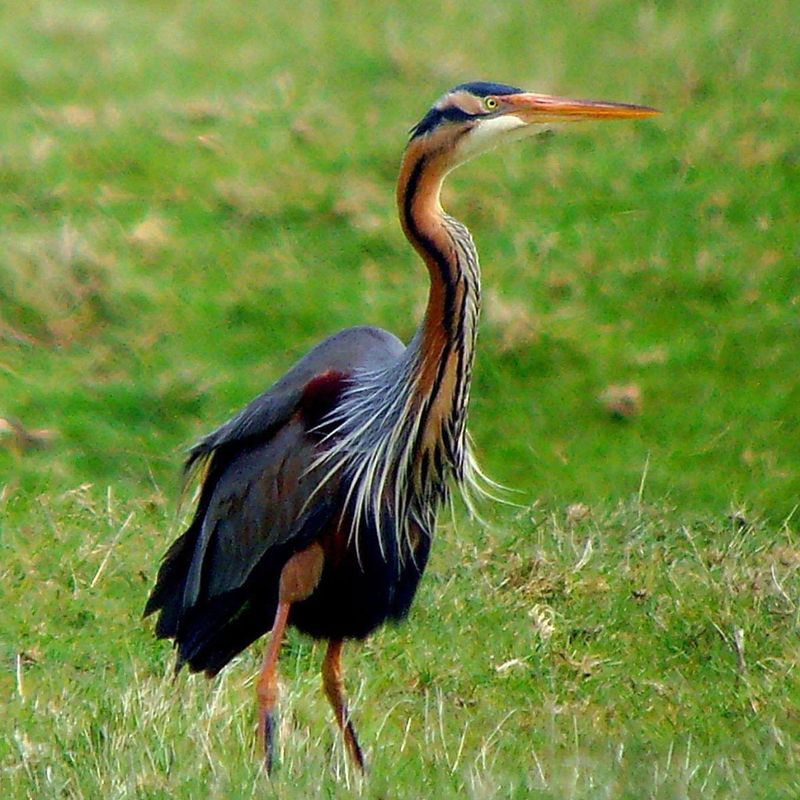
A picture of grace, the Purple Heron is a treat for the eyes. With its long neck and rich purple-gray plumage, it inhabits wetlands across Europe, Asia, and Africa.
Unlike its more robust relatives, this heron is shyer, often hiding among reeds. Its slender build aids stealthy movements, perfect for catching fish.
During migration, they travel long distances, a testament to their endurance. Observers admire not just their beauty but their resilience, whether seen in a European marsh or an African wetland. Every sighting is a memorable encounter.
Yellow-crowned Night Heron
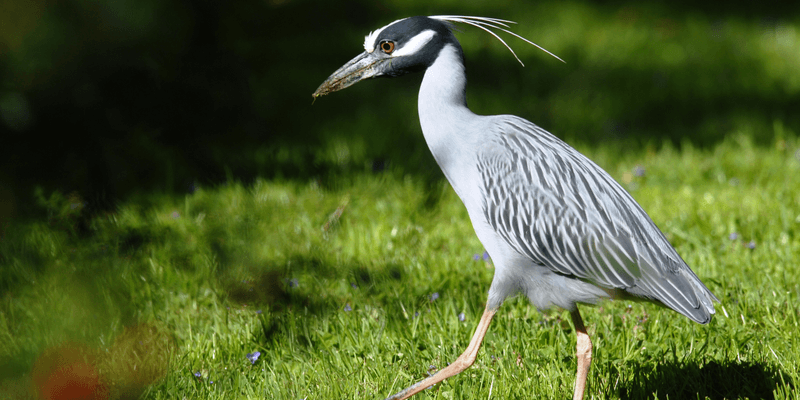
Distinctive and bold, the Yellow-crowned Night Heron commands attention with its vivid yellow crown. Found in coastal regions from the southeastern United States to South America, it thrives in mangroves and swamps.
This bird’s diet is specialized, with a preference for crustaceans like crabs. By day, it rests in trees, and by night, it forages along the water.
The Yellow-crowned Night Heron’s ability to adapt to both saltwater and freshwater environments showcases nature’s adaptability. Its presence in diverse habitats offers endless opportunities for bird enthusiasts to marvel at its striking appearance.
Cattle Egret
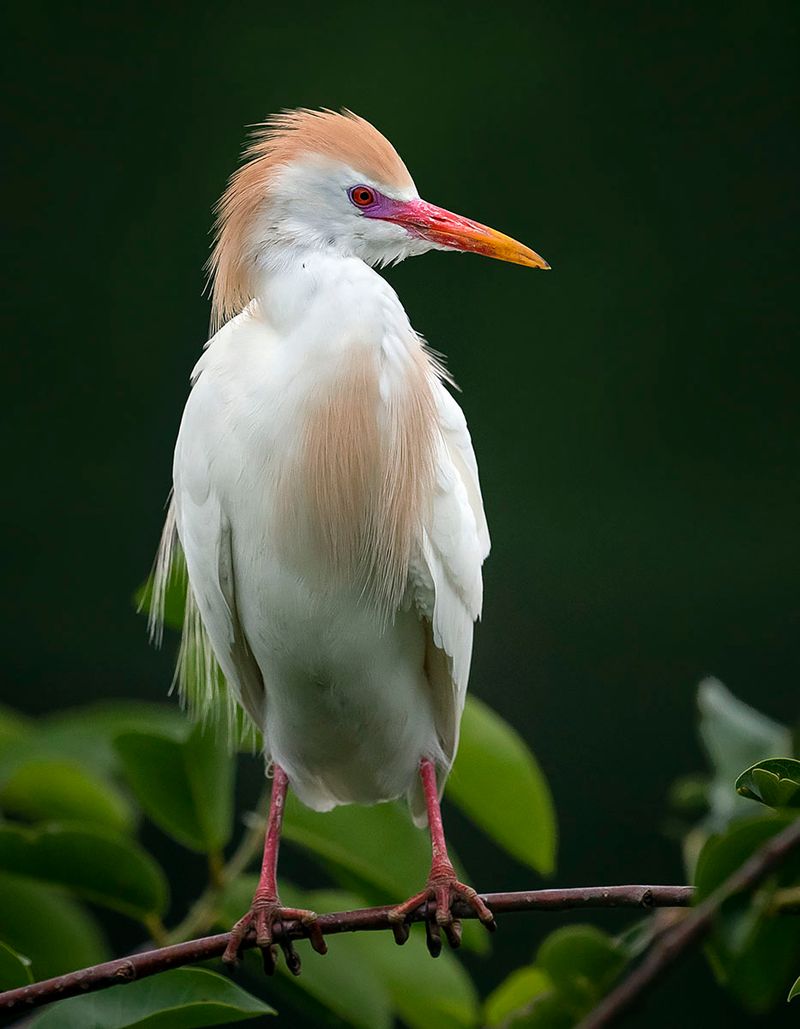
From farmland to urban areas, the Cattle Egret is a versatile traveler. With origins in Africa, it now roams across the Americas, Europe, Asia, and Australia.
Unlike other herons, it often follows livestock, feeding on insects disturbed by the animals. This unique behavior bonds them with cattle, a sight common in rural landscapes.
During breeding, their plumage develops an orange hue, adding an extra dash of color to their usual white feathers. Observers enjoy watching these birds navigate both bustling cities and serene pastures with ease, always finding new ways to thrive.
Goliath Heron

The Goliath Heron stands as the largest heron in the world, with a wingspan that catches the eye. Native to sub-Saharan Africa, it dominates the shores of large lakes and rivers.
This giant heron feeds primarily on fish, reflecting its impressive hunting prowess. With a deliberate and calm demeanor, it waits patiently for the perfect moment to strike.
Its reddish-brown plumage and stately presence make it a favorite subject for photographers. Witnessing a Goliath Heron in flight or poised in its watery domain is a highlight for nature lovers visiting Africa’s waterways.
Black Heron
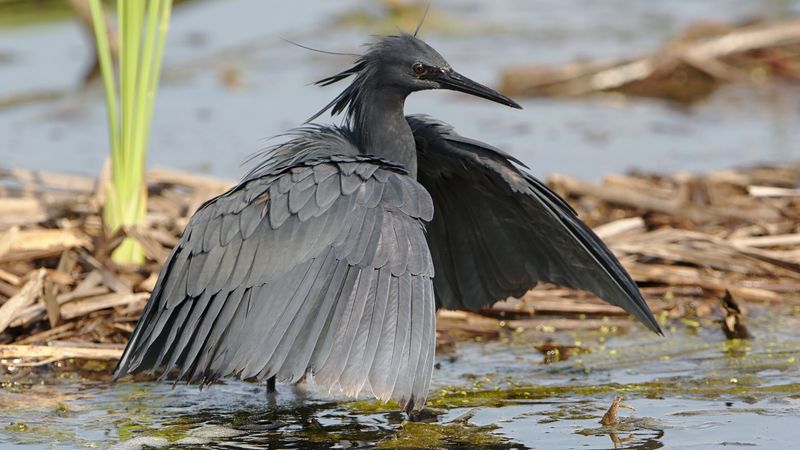
Unconventional and fascinating, the Black Heron is known for its unique hunting technique. Found in sub-Saharan Africa, it uses its wings to create a canopy, casting a shadow on the water.
This behavior, known as “canopy feeding,” lures fish into the shade, making them easier to catch. It’s a mesmerizing sight for observers.
This heron’s all-black plumage and innovative hunting strategy distinguish it from other herons. Whether seen manipulating light or simply basking in the sun, the Black Heron’s presence enriches the vibrant life of African wetlands.
Reddish Egret
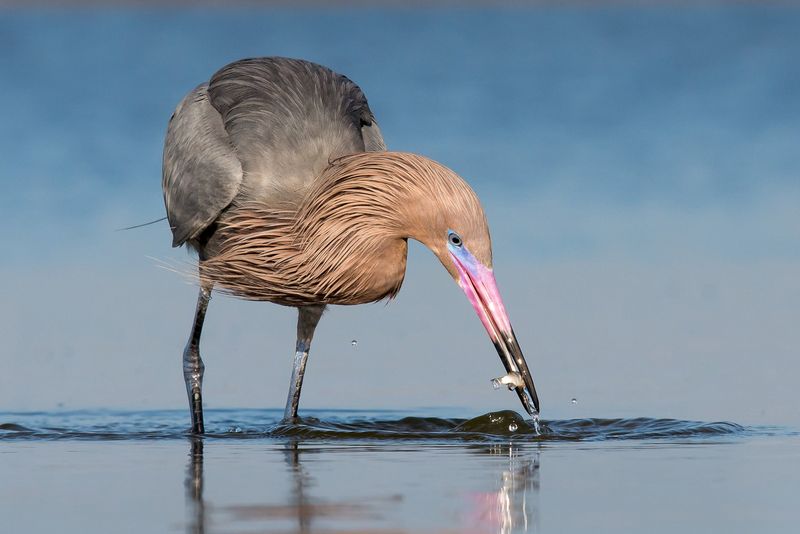
With flair and energy, the Reddish Egret captivates onlookers with its lively hunting dance. Inhabiting coastal beaches and lagoons of the Gulf Coast and Caribbean, its reddish feathers and animated behavior stand out.
Unlike its more reserved relatives, this egret dashes, twirls, and leaps in pursuit of fish. Its dance-like hunting style is both entertaining and effective.
This heron’s striking appearance and engaging antics make it a favorite among those exploring tropical beachscapes. For birdwatchers, encountering a Reddish Egret is a joyful spectacle, full of color and motion.
Tri-colored Heron
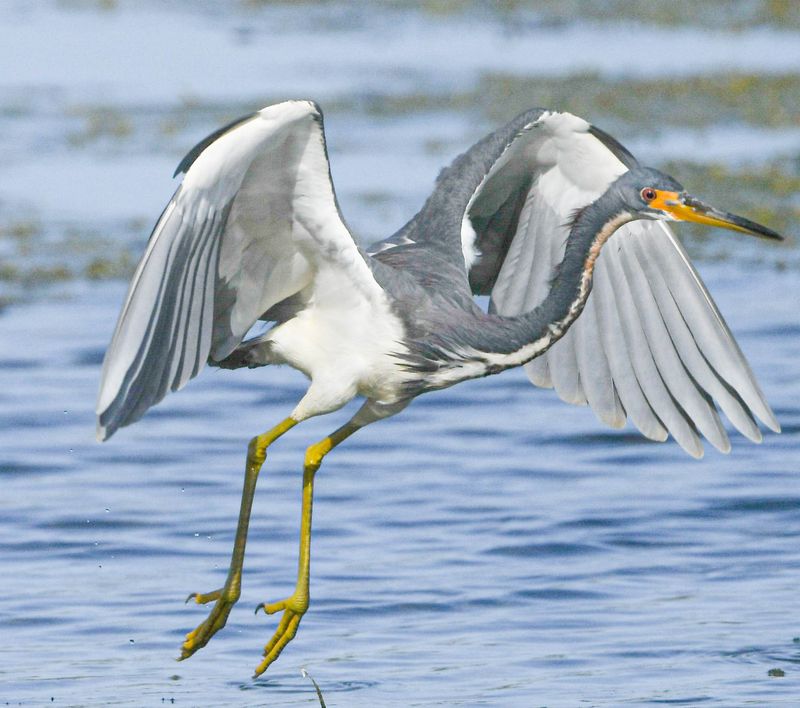
The Tri-colored Heron is a visual delight, with its blue, white, and reddish hues creating a striking ensemble. Found in the coastal regions of the southeastern United States and Central America, it inhabits marshes and swamps.
This heron’s foraging style is active and varied, chasing fish with agility. During breeding season, its plumage becomes even more vibrant, a testament to nature’s artistry.
Its adaptability to different environments showcases the Tri-colored Heron’s resilience. Observers enjoy its dynamic presence along the water’s edge, adding a splash of color to the natural landscape.
Chinese Pond Heron
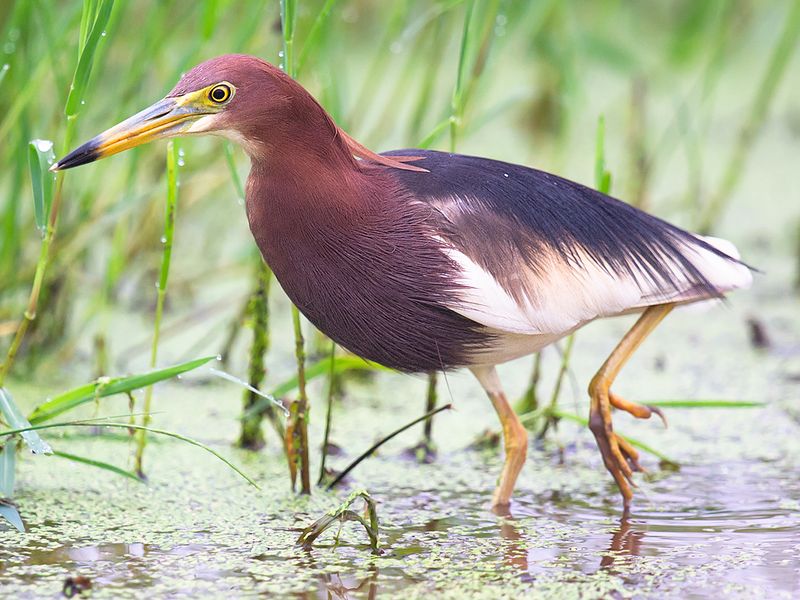
The Chinese Pond Heron is a master of transformation. Found in East Asia, its plumage shifts from subdued hues to vibrant colors during breeding.
Inhabiting rice paddies and freshwater wetlands, it’s a familiar sight in rural landscapes. This heron’s adaptability to human-modified environments reflects its survival instincts.
With a keen eye for fish and insects, the Chinese Pond Heron hunts with precision. Its presence in bustling agricultural areas highlights the connection between traditional farming practices and natural ecosystems, offering a glimpse into harmonious coexistence.

